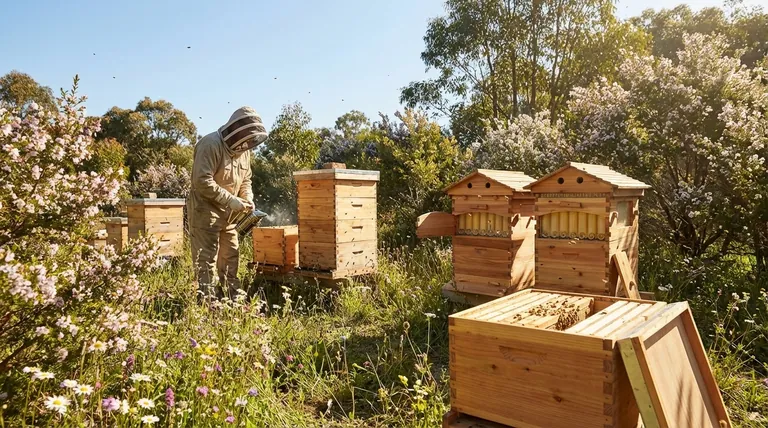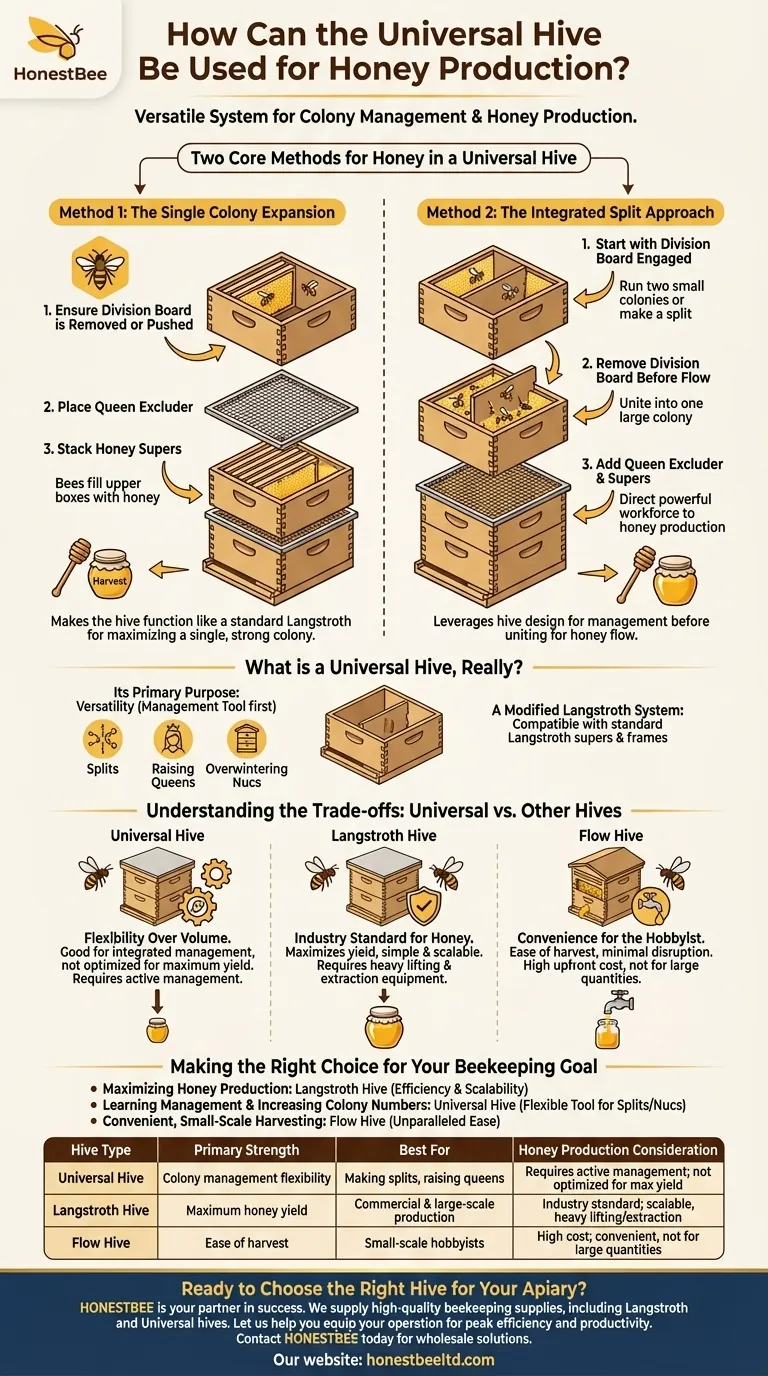To use a universal hive for honey production, you can either treat it like a standard hive by engaging the division board to create a single strong colony and then stacking honey supers on top, or you can manage a split within the hive and later remove the divider to allow the unified, larger population to focus on honey gathering. The hive's core design is built around this internal partition, making it a flexible management tool.
The universal hive is a versatile system designed for colony management, such as making splits and raising queens, that can be adapted for honey production. However, it is not optimized for it in the way a standard Langstroth hive is, which is purpose-built for maximizing honey yield through simple vertical expansion.

Two Core Methods for Honey in a Universal Hive
The universal hive’s defining feature is its internal division board, which allows a single hive body to be partitioned. Your strategy for honey production depends on how you use this feature.
Method 1: The Single Colony Expansion
This is the most straightforward approach and makes the universal hive function like a standard Langstroth hive.
First, you ensure the division board is either removed or pushed to one side, allowing the queen to use the entire brood box. The goal is to build one large, powerful colony.
Next, place a queen excluder on top of this single brood box. This prevents the queen from laying eggs in the honey frames.
Finally, you stack honey supers on top of the queen excluder. The bees will fill these upper boxes with honey, which can then be harvested.
Method 2: The Integrated Split Approach
This method leverages the hive's core design for colony management as a prelude to honey production.
You begin with the division board engaged, creating two separate compartments within the brood box. This allows you to run two small colonies or make a "walk-away split" in a single box.
Once you have a strong, queenright colony on one or both sides, you can remove the division board. This unites the bees into one large, populous colony just before or during a major nectar flow.
This newly powerful workforce can then be directed toward honey production by adding a queen excluder and supers, as in the first method.
What is a Universal Hive, Really?
Understanding the universal hive's intended purpose is key to understanding its role in honey production. It is a management tool first and a production hive second.
Its Primary Purpose: Versatility
The true strength of the universal hive is its flexibility. It is designed to let beekeepers perform multiple tasks within a single piece of equipment.
Its main uses include making splits, raising new queens, or overwintering two smaller nucleus colonies in one insulated box, which improves their chances of survival.
A Modified Langstroth System
At its core, a universal hive is simply a Langstroth-style hive body (often 8-frame) with a removable internal wall. This means it is compatible with standard Langstroth supers, frames, and other equipment.
This compatibility is what allows it to be used for honey production, but the process requires more management decisions around the division board compared to a simple Langstroth.
Understanding the Trade-offs: Universal vs. Other Hives
No hive is perfect for every goal. The universal hive's strengths in management create trade-offs for pure honey production.
The Universal Hive: Flexibility Over Volume
The primary benefit is integrated colony management. You can increase your apiary size without needing lots of separate nucleus boxes.
However, it is not designed for maximum honey output. The focus on internal division means it is less streamlined for the simple vertical stacking that defines large-scale honey production.
The Langstroth Hive: The Industry Standard for Honey
The Langstroth hive is the gold standard for beekeepers focused on maximizing honey yield. Its design is simple, scalable, and proven.
The trade-off is that it requires more work, including heavy lifting of full honey supers and the need for separate, often expensive, extraction equipment like a centrifuge.
The Flow Hive: Convenience for the Hobbyist
The Flow Hive prioritizes ease of harvest above all else. Honey can be extracted directly from the hive with minimal disruption to the bees and no extra equipment.
Its limitations are a significantly higher upfront cost and a design best suited for small-scale hobbyists, not for those aiming to produce large quantities of honey efficiently.
Making the Right Choice for Your Beekeeping Goal
The best hive is the one that aligns with your specific objectives.
- If your primary focus is maximizing honey production: The Langstroth hive remains the undisputed standard for its efficiency, scalability, and proven results.
- If your primary focus is learning bee management and increasing colony numbers: The universal hive is an excellent and flexible tool for making splits and managing nucs within a single box.
- If your primary focus is convenient, small-scale honey harvesting with minimal disruption: The Flow Hive offers a unique solution, trading higher cost for unparalleled ease of extraction.
Choosing the right hive is about aligning the equipment's design with your personal beekeeping objectives.
Summary Table:
| Hive Type | Primary Strength | Best For | Honey Production Consideration |
|---|---|---|---|
| Universal Hive | Colony management flexibility | Making splits, raising queens | Requires more active management; not optimized for maximum yield |
| Langstroth Hive | Maximum honey yield | Commercial & large-scale production | Industry standard; scalable but requires heavy lifting & extraction equipment |
| Flow Hive | Ease of harvest | Small-scale hobbyists | High upfront cost; convenient but not for large quantities |
Ready to Choose the Right Hive for Your Apiary?
Whether you're a commercial apiary focused on maximizing honey yield or a distributor seeking reliable equipment for your customers, HONESTBEE is your partner in success. We supply high-quality beekeeping supplies and equipment, including Langstroth hives optimized for production and versatile universal hives for advanced colony management.
Let us help you equip your operation for peak efficiency and productivity.
Contact HONESTBEE today to discuss your specific needs and get a quote on our wholesale-focused solutions.
Visual Guide

Related Products
- Honey Flow Garden Bee Hive Flow Hive Best Beehive for Beginners
- Langstroth Bee Hives Bee Keeping Box for Beginners Beekeeping
- 7 x Auto Bee Flow Hive Frames Plastic Beekeeping Hive Box Supplies
- Automatic Honey Flow Beehive 4 Frame Mini Hive for Beekeeping
- HONESTBEE Advanced Ergonomic Stainless Steel Hive Tool for Beekeeping
People Also Ask
- What are the advantages of using an Auto Flow Hive? Experience Gentle, On-Tap Honey Harvesting
- What are the benefits of a Flow Hive? Revolutionize Your Harvest with Ease and Care
- What are the advantages of using a Flow Hive? Simplifying Harvesting for Modern Beekeepers
- How does the Flow Hive reduce stress on bees during honey extraction? A Guide to Gentle Harvesting
- What are the benefits of the Flow Hive for novice beekeepers? Simplify Honey Harvesting & Reduce Stress



















